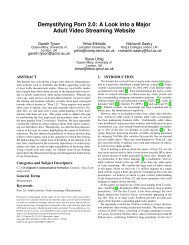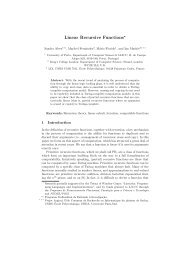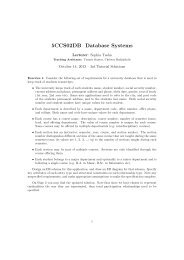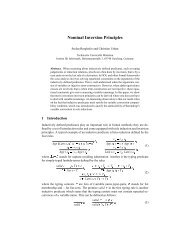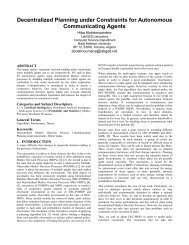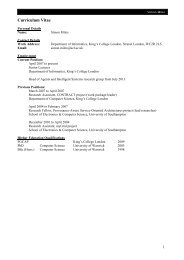Upgrade Report - Department of Informatics - King's College London
Upgrade Report - Department of Informatics - King's College London
Upgrade Report - Department of Informatics - King's College London
- No tags were found...
Create successful ePaper yourself
Turn your PDF publications into a flip-book with our unique Google optimized e-Paper software.
5 GRAPH GENERATION MODELS 8Figure 1: Erdós-Rényi Graph G(n, p) graph with n = 50000, p = 0.00015.2 Preferential attachment modelThe preferential attachment model is a graph process used to generate graphs with degree distributionswhich follow a power-law. This generative method was proposed by Barabási and Albert [5] as a generativeprocedure for a model <strong>of</strong> the WWW. Surveys by Bollobás and Riordan [7] and Drinea, Enachescuand Mitzenmacher [21] give many related generative procedures to obtain graphs with power-law degreesequences.In this model, the graph G(t) = G(m, t) is obtained from G(t−1) by adding a new vertex v t with m edgesbetween v t and G(t − 1). The end points <strong>of</strong> these edges are chosen preferentially, that is to say proportionalto the existing degree <strong>of</strong> vertices in G(t − 1). Thus the probability p(x, t) that vertex x ∈ G(t − 1) ischosen as the end point <strong>of</strong> a given edge is equal to p(x, t) = d(x, t − 1)/(2m(t − 1)), and this choice is madeindependently for each <strong>of</strong> the m edges added. A model generated in this way has a power law <strong>of</strong> 3 for thedegree sequence, irrespective <strong>of</strong> the number <strong>of</strong> edges m ≥ 1 added at each step.It was empirically shown by Barabási that there are two required elements in order in order to obtain apower-law degree distribution and two models were defined.Model A This model retains growth but all new vertices created are attached UAR on existing edges.Model B This model consists <strong>of</strong> a graph with a static vertex count which at each epoch (or time frame)an edge is added preferentially.Each <strong>of</strong> the individual models above fails to create scale-free graphs, and it is shown in [5] that only bya combination <strong>of</strong> models A and B do we obtain a power-law degree distribution.Preferential attachment graphs have a heavy tailed degree sequence. Thus, although the majority <strong>of</strong> thevertices have constant degree, a very distinct minority have very large degrees. This particular propertyis the significant defining features <strong>of</strong> such graphs. A log-log plot <strong>of</strong> the degree sequence breaks naturallyinto three parts. The lower range (small constant degree) where there may be curvature, as the power lawapproximation is incorrect. The middle range, <strong>of</strong> large but well represented vertex degrees, which give thecharacteristic straight line log-log plot <strong>of</strong> the power law coefficient. In the upper tail, where the sequenceis far from concentrated, and the plot is a spiky mess. Due to the structure <strong>of</strong> the model as well as theextensive analysis that has been done, this is going to be the main reference model for our experiments.



